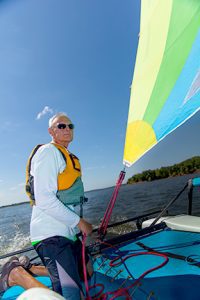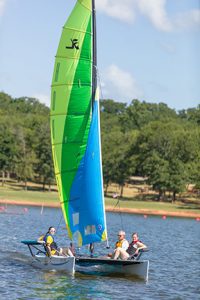Many Oklahoma sailors have been at the sport since childhood, but theirs is a skill that can be learned at any age. Sailing clubs are a great place to start.

Thunderbird Sailing Club offers classes for kids and adults and enrollment fills up fast, says Jerry Lojka, a former club commodore and volunteer sailing instructor. A retired firefighter, Lojka loves the solitude of taking his multi-hulled catamaran out on Lake Thunderbird near Norman; he finds the weeklong sailing camps just as rewarding.
“Kids come who have never been on a boat,” Lojka says. “They are on the water by themselves by the end of the second day or beginning of the third day, depending on the wind. By the end of the fourth day, they are often proficient.”
Another club benefit is that members can try before they buy, or never own a sailboat at all, says Kurt Hagen of the Grand Lake Sailing Club near Grove. A fleet membership allows people to use the club’s boats. Associate members “just enjoy the socializing and go out sailing with other members,” says Hagen, a retired geologist.
Greg Thomas, rear commodore of the Oklahoma City Boat Club at Lake Hefner and a member since 1989, describes sailing as “just a magical experience – to be out there on the water without any motor, just working with the wind to take your boat where you want it to go.”
Of Lake Hefner, Thomas adds: “We think it’s one of the top 10 sailing venues in the country, but … we are kind of prejudiced. It sits up high. The wind is not obstructed by buildings.”
At 86, Hagen proves that sailing is a lifelong sport. When he was 12, he and his older sister joined a club and started racing every summer weekend in their native Wisconsin. He says he didn’t sail for a while after his career took him to Colorado, but he joined the Grand Lake club in 1986 after moving to Oklahoma. He and his wife, Patsy, eventually retired at the lake and are often on the water in their Catalina 27-foot sloop with two sails, called a main and a jib.

Having learned to sail as a Boy Scout in his native Utah, Lojka also resumed the sport after moving to the state.
“I found out it has more sailing lakes than most states, he says. “I have been on 23 of Oklahoma’s lakes, and I wasn’t disappointed in any of them.”
Skeeter Chilton, commodore of Windycrest Sailing Club at Lake Keystone near Prue, has sailed since 1968.
“Being out and sailing your boat, making the sails trim to the optimum, and all you hear is the wind through your sails and the water rushing by – it’s very idyllic,” she says. “I love that you take what you know and you apply it to the sails and the way you are sitting on the boat to make the boat go faster. It’s an art.”
Stan Nieves, a past commodore of the Oklahoma City Boat Club and owner of OKC Boatworks, repairs watercraft and sells a few sailboats every year on consignment. He says when people buy a sailboat for the first time, it should be small and easy to sail because they can always trade up – and most do.
“The thing about sailing is that it’s more of a disease,” Nieves says with a laugh. “The … cliché is you are not a true sailor until you have owned 100 feet of waterline, not necessarily on one boat. So if you’ve had four 25-foot boats, you can call yourself a sailor.”
Nieves says a small, used sailboat can cost between $1,000 to $2,000.
“Fiberglas is really durable, he says. “Older boats are cheap because there are so many out there.”
Young people looking to get their feet wet often start with a centerboard, a one-person boat, Nieves says.
“You are sitting inches above the water,” he says.
Sailors often graduate to keelboats after they have children, he says, because they are designed for multiple passengers and have more amenities and storage areas.
However, “bigger is not better,” Hagen says. “Until you are experienced, anywhere from 14 to 22 feet is good for a starter. A lot of people trade up after they get more skilled. They want a boat they can sleep on and anchor out overnight.”
A new 14-foot sailboat runs about $5,000, Hagen says.
Buyers also have to consider sails.
“All boats will have at least a main sail,” Nieves says. “The more advanced will have a main, a jib and a spinnaker. The spinnaker is the big colorful sail that’s way out front. When you have all three sails, you need two to three people.”


























